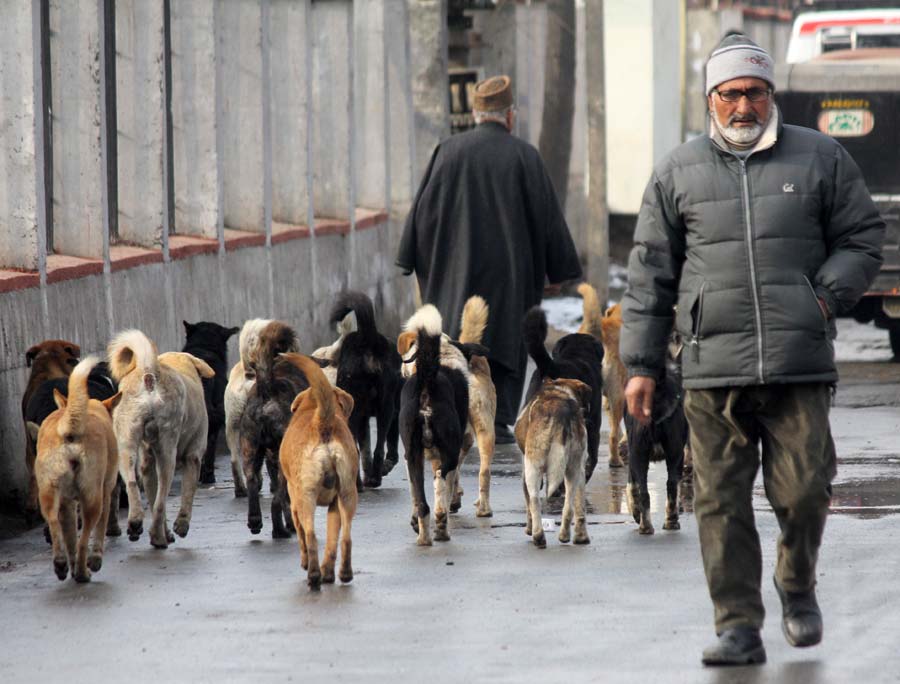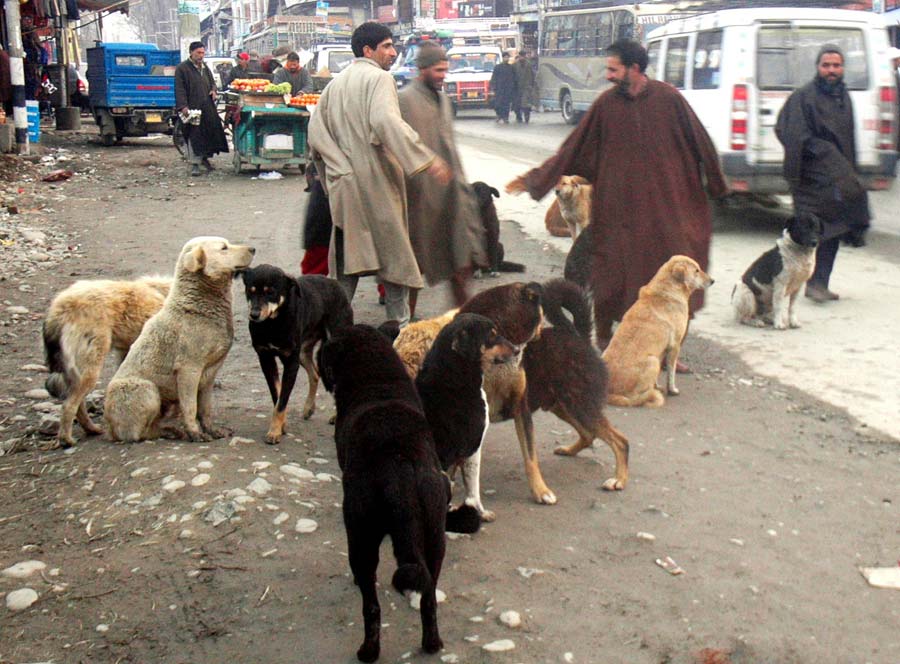With the ever-increasing dog population threatening the people within and outside the city, domestic cats are gradually emerging as another key player. Syed Shadab Ali Gillani reports the dog-and-cat game that survivors resort to for staying away from fatal Lyssavirus
The tragic death of a Ramabn police officer shocked Jammu and Kashmir. The news of a seemingly innocuous dog scratch leading to the officer’s demise of Rabies has left many deeply unsettled, prompting concerns about the circumstances that ultimately led to his painful death.
Assistant Sub Inspector (ASI) Mohammad Rafiq Naik tragically succumbed to rabies due to being scratched by a rabid dog. Despite encountering the animal almost 90 days ago, the 52-year-old’s condition deteriorated to a point of no return. Multiple hospitals confirmed the diagnosis as his symptoms spiralled out of control. Even the All India Institute of Medical Sciences (AIIMS), could not help him. Sadly, Naik’s life came to an end in Akhnoor before he could reach his residence.
This incident served as a stark reminder of the dire consequences that can arise from negligence and ignorance when it comes to taking precautions around animals.

Occurrence
Recent data and medical records paint a concerning picture of the escalating rabies cases in Kashmir over the past few years. Despite the common belief that rabies spreads solely through infected dogs, not many people know that domestic cats are also emerging as a new player in the animal attacks crisis. This year, the SMHS-run Anti-Rabies Clinic (ARC) got 1100 cases of cat attacks.
Rabies is a zoonotic disease, which originates in animals – in dogs and cats in Kashmir case – and infects humans.
“When we analyse diseases, we categorise them as bacterial, viral, protozoal, and helminthic,” Dr Salim Khan, Professor and Head of Community Medicine at Government Medical College (GMC) in Srinagar, explained. “In the case of rabies, it is a viral disease caused by the Lyssavirus. This virus predominantly targets the nervous system, triggering considerable changes in the host’s body upon infection.” Unlike some viruses that spread through the bloodstream, he pointed out the Lyssavirus spreads through nerves. “It infiltrates the spinal cord via the nerves first, eventually reaching the brain.”
Its infection encompasses the emergence of various phobia-like symptoms, including aversion to water and light. Individuals affected by rabies exhibit a range of behaviours. Even minimal contact or water droplets provoke spasms due to the static brain activity causing muscle contractions. Gradually, exhaustion sets in, leading to cardiac arrest and an agonising death.
The World Health Organisation (WHO) has classified rabies exposure into three categories. Category I exposure, involving mild contact like touching or feeding animals, doesn’t necessitate prophylaxis. Category II, comprising minor scratches or nibbling on the skin, demands immediate vaccination. Category III, which encompasses deeper bites, scratches, and exposure to saliva, mandates prompt vaccination and rabies immunoglobulin administration.

Dr Salim highlights additional implications, noting, “Encephalitis, an inflammation of the brain, triggers the ensuing effects. The virus can also target the glands, kidneys, liver, and heart, as well as salivary glands. This explains the rapid progression to the brain in animals affected by rabies, initiating a cycle of madness.”
He expounds on the recognizable signs of rabies by stating that two distinct manifestations of rabies exist – in 90 per cent of cases, rabies induces aggressive behaviour, while in 5-10 percent of cases, it leads to a mute demeanour. The afflicted animals often retreat to corners, marked by red spots, yet they remain contagious. Dogs typically come into contact with strays or wild creatures outdoors. Following viral entry, an incubation period transpires before rabies symptoms surface. Finally, aggression prompts erratic behaviour and incessant running, characteristic of this disease.
The Attacks
Barely three days after Eid ul Adha 2023, a distressing incident unfolded in Kupwara. Approximately 20 individuals fell victim to a dog attack, sustaining various injuries. Many suffered severe abdominal wounds, but prompt medical attention spared them from the perils of rabies.
Abid Khan was one of the survivors. “Though my arm bore a severe injury, I diligently followed doctors’ prescriptions for timely vaccinations,” Khan said. While the scars remain, the fear of rabies no longer looms over them.
In a different recent case, a heart-wrenching image of an eight-year-old boy from Awantipora circulated widely on social media. The boy was shown covered in dog bite wounds and stitches, with injuries extending even to his lungs. The incident unveiled the brutal attack inflicted by a pack of 20 dogs, leaving the young boy grievously harmed.
Dr Khan disclosed alarming statistics that ARC recorded. “In terms of bite cases, this year has seen approximately 5000 to 6000 reported incidents, which was slightly lower due to lockdown measures, ranging from 4000 to 4500,” he said. In the pre-Covid19, specifically in 2019-2020, they encountered around 7000 cases of animal bites. Excluding the pandemic period, the figures have consistently ranged between 6000 and 7000 cases.
The clinic got 2200 dog bite cases between April and August 2023. In 2022-23, ending March 6855 animal bite cases were managed by the clinic. “Daily, we receive an average of 25-35 animal bite cases, predominantly dog bites,” Dr Salim adds.
Additionally, Dr Salim emphasised that they diligently administer anti-rabies injections to those injured in instances of human and wild-animal conflict.
Prevention
Following an animal bite or scratch, the response has to be quick and robust. “When an animal bites, the skin becomes contaminated. It is crucial to wash the area with water and soap or detergent for 10 to 15 minutes to neutralise the contamination,” Dr Khan said, insisting the next stop must be a hospital. Over the past three decades, Dr Salim has noted significant changes in rabies vaccination and treatment. “We now administer a new cell culture vaccine. It comes in two categories: intramuscular or subcutaneous injection. The vaccination is given over five different days.”
Rabies is an entirely fatal infection. “Rabies is both 100 per cent preventable and almost 100 per cent fatal. Proper precautions and timely treatment are vital. That is the cornerstone of managing any animal exposure.”
Dr Tawheed, the Veterinary Officer of Srinagar Municipal Corporation (SMC), holds individuals in the meat and poultry sector responsible for irresponsibly disposing of the offal, despite SMC offering free waste management services.
“The alarming surge in dog bites and attacks in Kashmir has become a significant concern, particularly for vulnerable groups like children,” Tawheed stressed. “The emotional and psychological distress experienced by dog-bite victims underscores the need for policymakers to implement cost-effective mass dog vaccination initiatives and support programs for victims.”
Vaccination
Dr Iqbal Baba, a Srinagar resident, commends the efficacy of vaccination. He recounts his personal experience of being bitten by a dog in November 2022 and how he managed to mitigate the aftereffects through the sterilisation method.
“I initiated my treatment promptly,” Iqbal stated. “However, after seven days of immunoglobulin injections, I developed allergies and blisters on certain parts of my body”. He was among the few cases who experienced allergies. Nevertheless, he strongly recommends this injection and advises individuals to read the prescription carefully, especially those prone to allergies. Timely and cautious administration of this vaccination can yield remarkable results.
Allergies in a section of the patients can be a serious affair but they mostly survive after battling it for some months.

Sterilisation
SMC’s Dr Tawheed confirmed the operational state of the sterilisation facility in Shuhama, operating in collaboration with Sher-e-Kashmir University of Agriculture Science and Technology (SKUAST). “At the Shuhama centre, we are conducting 10-12 sterilisations daily. Our second centre at Tengpora, equipped with a capacity for over 200 kennels, is ready and will be operational soon. Additionally, our ABC centre at Chattarhama is currently in construction,” Dr Tawheed Revealed.
Dr Salim admitted that sterilisation and vaccination are the pivotal strategies for curtailing the disease’s propagation. He emphasises the complexity of the sterilisation process and the necessity of proper infrastructure and technical support.
Dr Salim insisted that garbage collection in the city must be robust. Suggesting that mobile garbage collection vehicles must circulate Srinagar city twice a day in a phased manner, he wants the society to be proactive and responsive. “Together, we can contribute to resolving this problem,” he hoped.
from Kashmir Life https://ift.tt/4N0kxu8
via IFTTThttps://kashmirlife.net
No comments:
Post a Comment